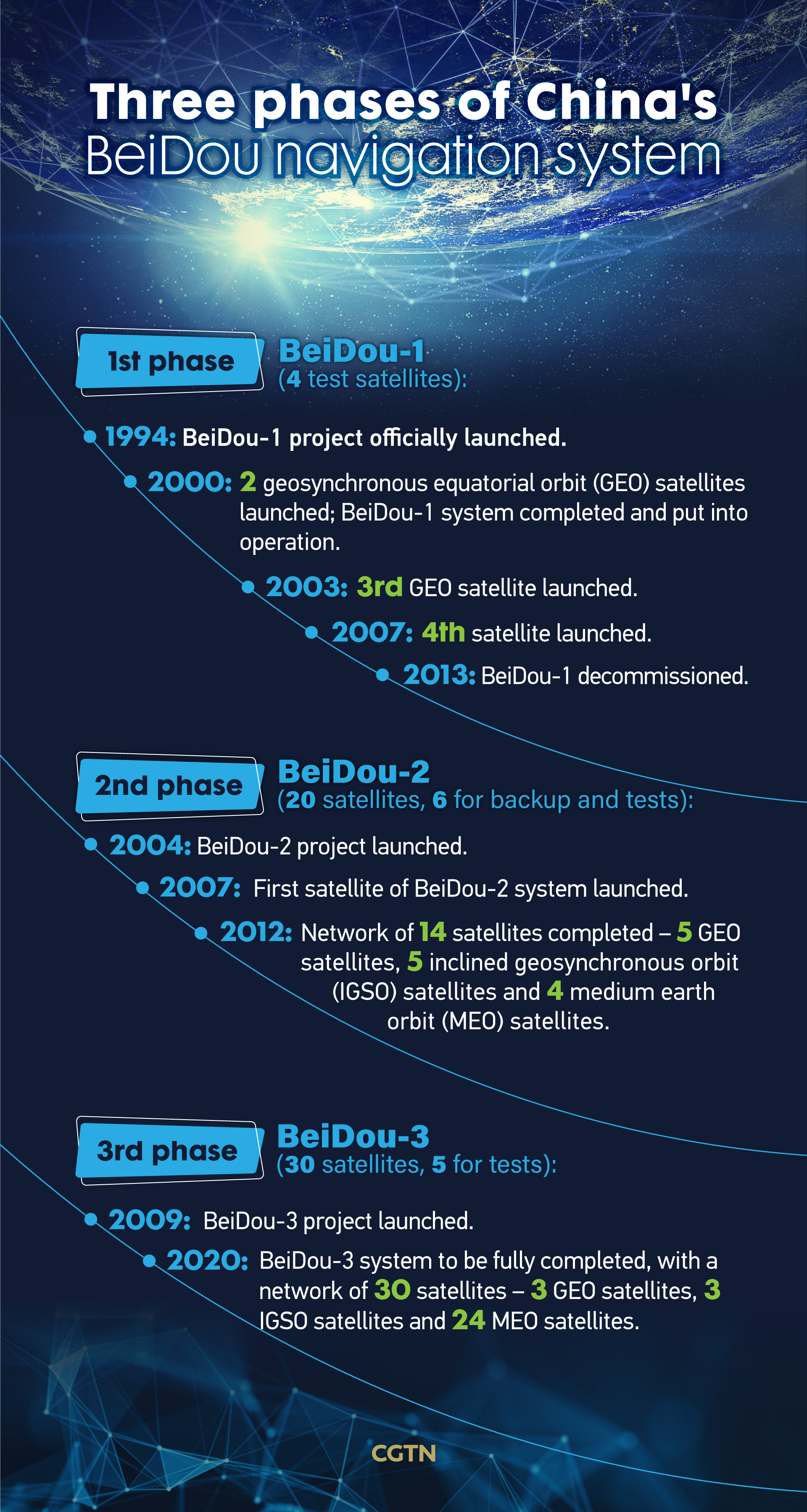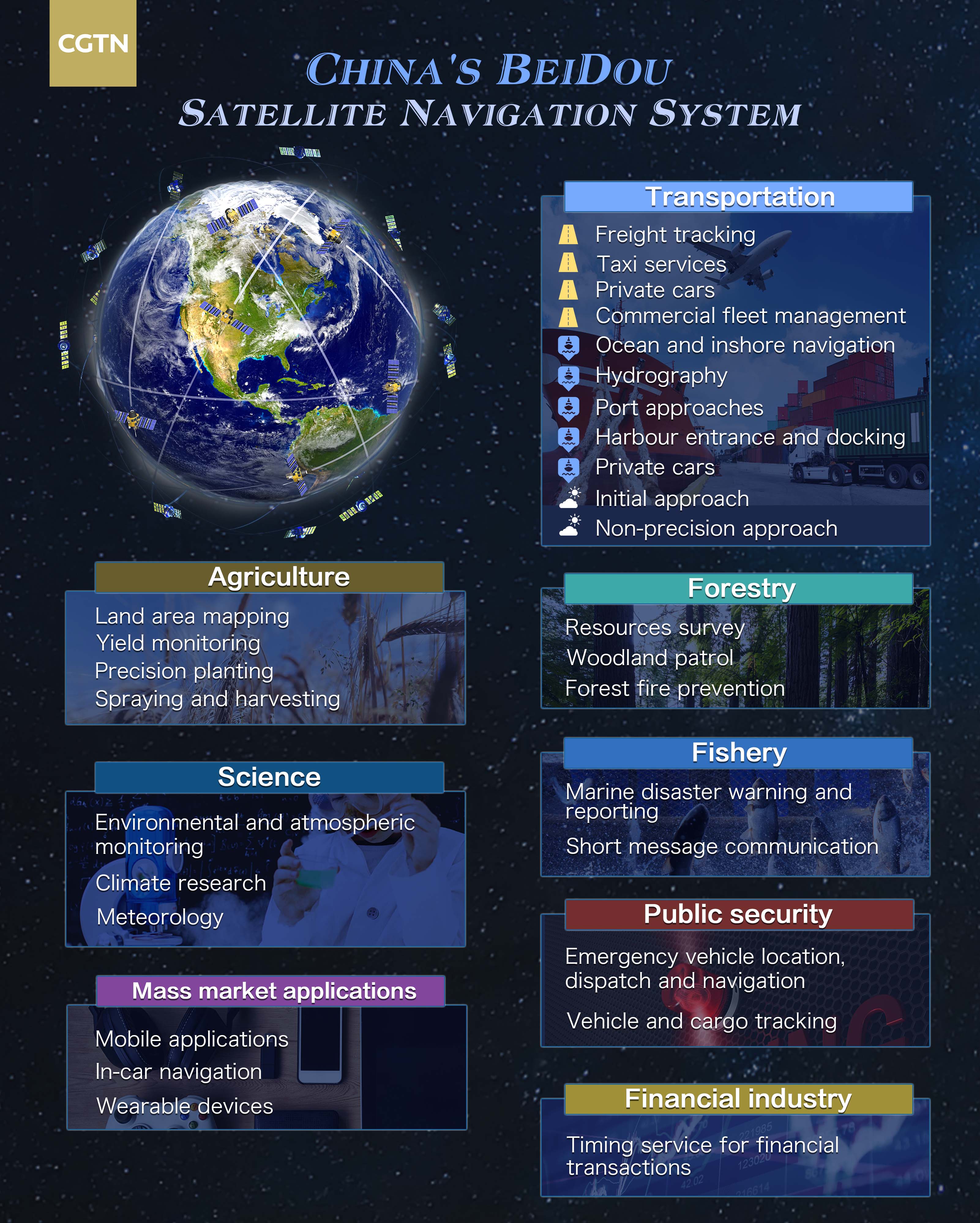02:52

The last satellite of the BeiDou Navigation Satellite System (BDS) was successfully sent into space from Xichang Satellite Launch Center in southwest China's Sichuan Province on Tuesday, marking the completion of the country's domestically developed BeiDou constellation – one of the four global navigation networks alongside the United States' GPS, Russia's GLONASS and the European Union's Galileo.
Three phases of BDS development

CGTN infographic by Chen Yuyang
CGTN infographic by Chen Yuyang
China began constructing its navigation system, named after the Chinese term for the Big Dipper constellation, in the 1990s and started serving the Asia-Pacific region in 2012. In more than 30 years, BDS has achieved a range of goals, such as shifting from active to passive positioning and expanding its service coverage from China to the Asia-Pacific region and eventually the globe.
The first phase involved building the BeiDou-1 system, officially began in 1994.
Two geosynchronous equatorial orbit (GEO) satellites were launched in 2000, and the BeiDou-1 system was completed and put into operation. A third GEO satellite was launched to further enhance the system's performance in 2003.
The completion of BeiDou-1 made China the third country after the U.S. and Russia to have a satellite navigation system. In 2013, the BeiDou-1 satellite was decommissioned.
The second phase involved building the BeiDou-2 system, shifting from active to passive positioning, and launching the regional navigation technology services for the Asia-Pacific region.
Construction of the BeiDou-2 system started in 2004. A network of 14 satellites was completed in 2012, which includes five GEO satellites, five inclined geosynchronous orbit (IGSO) satellites and four medium-earth orbit (MEO) satellites.
The BeiDou-2 system added a passive positioning system, which means user devices don't have to send signals and location can be determined just by receiving the signals. The completion of the BeiDou-2 not only serves China but also provides users in the Asia-Pacific region with positioning, speed measurement, timing and short message communication services.
The third phase involved the development of the BeiDou-3 system, which meant setting up "crosslink" and realizing global networking.
The construction of the Beidou-3 system started in 2009 and completed in 2020. The network comprises 30 satellites, including three GEO satellites, three IGSO satellites and 24 MEO satellites.
The BeiDou-3 system features both active and passive positioning, and solves the problem of global stationing for global networking utilizing "crosslink" or satellite-to-satellite connection "dialogue."
It serves global users with positioning, navigation, timing, short message communication and international rescue services, and also provides Augmentation System, Precise Point Positioning (PPP) and regional short message communication services in and outside China.

CGTN infographic by Du Chenxin
CGTN infographic by Du Chenxin
BDS application and market potential
BDS and its derivative devices have offered services to millions of users in the fields of transportation, maritime affairs, electricity, civil affairs, meteorology, fishery, surveying and mapping, mining and public security.
Its market value hit 345 billion yuan (48.58 billion U.S. dollars) in 2019, up 14.4 percent from the previous year, according to an annual industry report.
Vertical markets related to the development and application of the satellite navigation technology, including chip, algorithm, software, data, end devices and supporting infrastructure reported 116.6 billion yuan in output value, accounting for 33.8 percent of the industry's total.
The completion of the Beidou-3 constellation, along with China's "new infrastructure projects" with focus on smart technologies, will be a major engine driving growth in the BDS market, the report said.
(Story by CGTN's Gao Yun, Pan Zhaoyi, Zhang Ziyu and Guo Meiping; cover image via VCG)